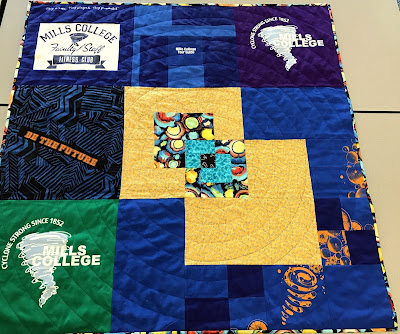
Block of the Month for February consisted of two interlocking circles of fused applique. I was
determined to finish the edges of said applique with satin stitching. I think in the past I have used mostly zigzag stitch for this;
satin stitch is merely a more closely spaced version of zigzag.
But I had heard that satin stitching requires a stabilizer--you know, a backing to help all those closely placed stitches stay nice and neat. A perfect opportunity to
learn new things play!
What kind of stabilizer works the best?*
*For my machine; using my particular threads; your mileage may vary
The contenders
- Advertised stabilizers: Pellon E-Z Stitch, Sulky Totally Stable, Therm-o-Web Stitch n Sew
- Other "frugal" materials: freezer paper, paper towels, backing paper from Wonder Under
A note on threads & needles
I tried my six different stabilizer samples using three different threads. Each thread was paired with a specific bobbin thread (following advice I read somewhere to use lighter weight thread in the bobbin when satin stitching).
- My regular cotton piecing thread: Presencia 50 wt; bobbin: Presencia 60 wt (just slightly thinner).
- A hefty cotton topstitching thread: Sulky Blendables in 12 wt (this brand also comes in 30 wt); bobbin: Presencia 50 wt cotton
- Shiny, specialty thread: Sulky Rayon 40 wt; bobbin: Coats & Clark polyester
Needle: Schmetz Topstitching machine needle, size 90/14 was used throughout. That thing is a workhorse; color me impressed.
Hints
I read lots of advice on setting up for machine satin stitch before I tried my hand at it. Recommendations that stood out to me:
- Use thicker thread; thinner thread as a bobbin
- Use the correct needle for your thread; a size 90/14 is often recommended even when using your usual piecing/sewing thread
- Loosen upper thread tension a bit
- Consider using an embroidery foot for your sewing machine, if one is available
- Release presser foot tension, if you have that option
- Go slowly, especially if you have tight curves or corners to navigate
- Pivot frequently along tight curves (not an issue for my samples)
- Try not to pull or tug on the fabric; let the feed dogs do the work
Practice, practice practice
For each combination of stabilizer and thread, I stitched a bit on an extra chunk of fabric that used the same fusible applique method as my BOM block. I did this to check that the tension setting, stitch length and width appeared to still be working.
My machine recommended stitch length of 0.3-0.5 mm; I found that 0.4 mm worked best for all my samples.
Recommended stitch width was 2-5 mm; I used widths of 3.4-3.8. If I were outlining a complicated design, I might choose narrower width for lesser details or super-curvy edges.
After each test, I checked for puckering, fabric distortion, and ease of removal of the stabilizer product. When I had a combination I liked, I went ahead and stitched on the actual blocks for my project. I knew I wanted to use at least two different threads in the finished block.
Results
I have to keep in mind that I was only outlining gentle curves, so I didn't put each product to a rigorous stress test. Even so, I noticed some differences in how well the feed dogs reacted, how well the fabric remained un-distorted, and how "stabilized" I felt the block to be during the stitching process.
Fewer differences were evident in the ability to cleanly tear away each product. (Again, not a lot of details, curves and tiny points/valleys to really test this feature.)
And, most surprisingly, not a lot of difference in the
appearance of the actual stitching. Every product gave me a lovely satin stitch.
Pellon E-Z Stitch: my feed dogs didn't love it, and it was one of the two products that would worry me most for tearing away from intricate designs. On the positive side, no real distortion of my curve, as it felt like the product "gripped" my fabric the best of those needing to be pinned in place.
Sulky Totally Stable: my favorite! Maybe this was an unfair grouping of products--Totally Stable actually adheres to the fabric (via a quick touch of the iron); most of the others rely on pins. Regardless, this product performed well; thumbs up from my feed dogs, from keeping the block distortion-free, easy release of the fusing from the fabric and easy tear away from the stitching. It also appears to be re-usable (except where the stitching was), making it somewhat economical. But I don't consider it to be too expensive of a product anyway.
Therm-o-Web Stitch n Sew: my second favorite! Although it has to be pinned into place, Stitch n Sew adheres well to the fabric, flows nicely under the feed dogs, keeps the distortion at bay, and also tears away nicely.
 |
| Trying out the "frugal" options |
Freezer paper: although it adheres to fabric, I have always found the stiffness of Freezer Paper to be a problem when I need to maneuver my work. For use as a stabilizer, I wouldn't choose it.
Paper towels: this product actually gave me the most problem with distortion. And I doubt its ability to tear away from the stitching easily--which threatens further distortion. Thumbs down.
Backing paper from Wonder Under: why not? Re-use of a product that would otherwise go straight into the trash? Not too bad, as long as your pinning is thorough. Was a tiny bit slippery under my feed dogs, but otherwise acceptable. And the price was right.
Thanks for playing along! I have some new knowledge under my belt, and I will feel confident
if when I next try some satin stitching. Really digging this year's Block of the Month at
my shop.
 |
| Close-up: flashy Sulky Rayon (in turquoise) and modest Presencia cotton |
















